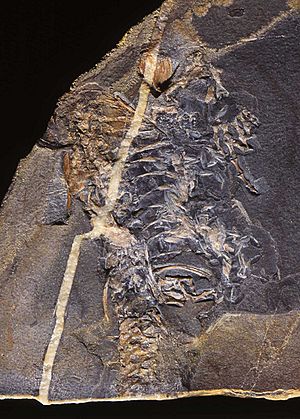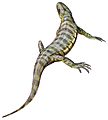Casineria facts for kids
Quick facts for kids CasineriaTemporal range: Middle Mississippian
|
|
|---|---|
 |
|
| Casineria kiddi from the Lower Carboniferous of Scotland | |
| Scientific classification | |
| Kingdom: | |
| Phylum: | |
| Subphylum: | |
| Class: |
Amniota (uncertain)
|
| Order: |
(uncertain)
|
| Genus: |
Casineria
|
| Binomial name | |
| Casineria kiddi |
|
Casineria was a tetrapod which lived 340 million years ago (mya) in the Mississippian. It was a small animal, length about 15 centimeters.
It lived in what was then a fairly dry environment in what is now Scotland. It had a mosaic of 'basal' (= primitive) amphibian and 'derived' (= advanced) amniote characters.
Casineria was at or very near the origin of the amniotes. It may have been one of the very first true amniotes. The only fossil lacks key elements: most of the skull and the whole lower body is missing. This makes exact analysis difficult.
Casineria was an insectivore. This earliest amniote had five fingers with claws on each hand, and marks the earliest known clawed foot.
Its name, Casineria, is a latin version of Cheese Bay, the site near Edinburgh, where it was found.
Discovery
In 1992, an amateur fossil collector spotted the remains of this four-legged creature on the shore of Cheese Bay, Scotland. For the next five years, the fossil waited at the National Museum of Scotland in Edinburgh while researchers focused on other projects. In 1997, work began to expose the remainder of the fossil from the surrounding matrix of stone.
The work revealed that the animal probably lived in an environment much drier than previously understood. The findings were first reported in 1999.
Phylogenetic relationship
Casineria shows features that ties it in with early tetrapods, notably a generally gracile (slim) build with light leg-bones, unfused ankles and toes ending in claws. This would enable the animal to use their feet actively in traction, rather than as holdfasts. This indicates a mainly terrestrial lifestyle. These traits shows it was closely related to amniotes.
With its advanced features, Casineria may have been one of the very first true amniotes, that is, egg-layers before the split between Synapsids and Sauropsids. Casineria pushes back the origin of amniote lineages much further than was previously realized.
Casineria and its relatives were perhaps the first vertebrates to live and reproduce on land.
Images for kids


